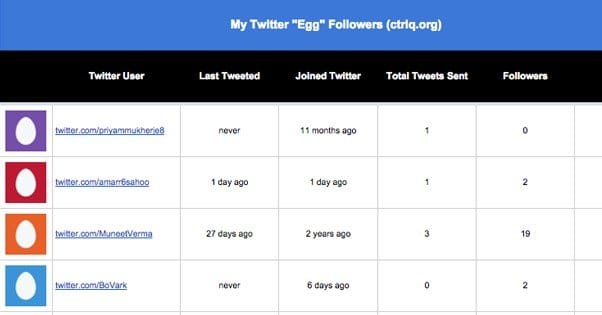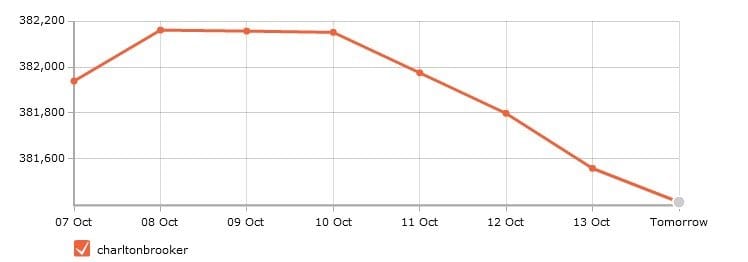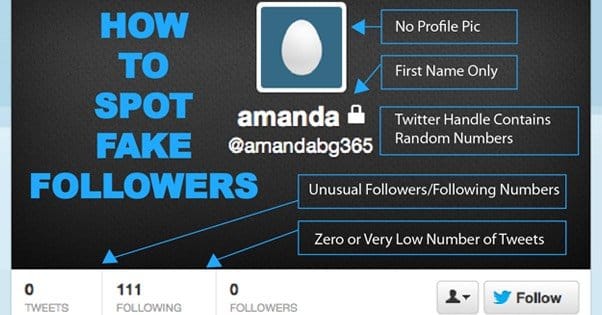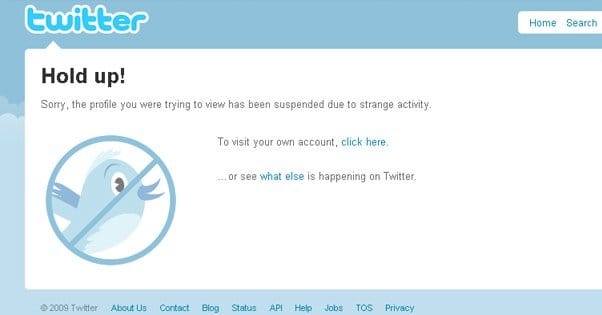 Written by ContentPowered.com
Written by ContentPowered.com
By now, everyone knows that fake followers on Facebook are hugely detrimental to your profile. Just scroll back through the posts on this blog and you’ll see half a dozen articles about it. What about other sites, though?
Take Twitter, for instance. The primary reason fake likes are bad on Facebook is because of EdgeRank, their algorithm for sorting who gets to see your posts. Facebook will show your posts to some fake followers, which decreases your reach and makes it harder to grow.
Twitter doesn’t have EdgeRank, or any filtering algorithm at all. It’s strictly time-based. Log on and you see the most recent tweets, receding back through time and refreshing when new tweets appear.
It seems as though fake followers, then, would be inconsequential. You don’t have to worry about real people not seeing your tweets because they were shown to fake users instead. You don’t have to worry about fake user posts showing up in your feed; you’re probably not following them, and even if you are, they aren’t posting.
The fact is, fake Twitter followers can be detrimental just like fake followers on Facebook, only in a different way. Let’s look at how.
It’s Can Be a Waste of Money
The first problem with buying fake followers isn’t actually about it hurting your brand or your profile; it’s about hurting your wallet. Fake followers seem to run in general around $1 for 100, and are sold in blocks of 1,000 or 2,500 or 10,000, or more. Some high profile buyers – celebrities, generally – even buy in the hundreds of thousands. I don’t know of a bot net out there with millions of profiles to throw around, but if you told me one existed, I wouldn’t be surprised.
So, say you want to buy 10,000 fake followers. That’s only $100, right? It’s not a huge loss, if they’re fake. I’m here to tell you that logic is wrong.
You’re not just looking at a loss of $100. Sure, every possible means of marketing can fail and flop, and it’s a loss of money. The problem is that with other ad techniques, there’s a good chance at success. Buying fake followers is completely, 100% not going to be useful to you in any way.
It gets worse, though. Not only are you losing that $100, you’re also losing the benefits you would have gotten from spending that $100 in a better way. For example, Twitter promoted tweets tend to top out at $2 per engagement action, so $2 for a retweet, reply, favorite, or link click. Exposure is free; people can see the ads but don’t have to engage, so it’s free brand building as well. For $100, you can get 50 elements of engagement, which is far from nothing.
You can even extend this to be cyclical. That additional exposure you get is diminished by Twitter showing those promoted posts to fake accounts. If you’re particularly unlucky, some of those bots are sophisticated enough to occasionally retweet content, eating your ad budget without benefitting you in any way.
You Get No Engagement
Never you mind that last line in the previous paragraph. 99.99% of the fake follower accounts out there exist for exactly one purpose; following pages. They don’t tweet, they don’t retweet, they don’t favorite, they don’t reply, and they don’t click links. They only perform one action, and only at the direction of the owner of the bot network.
Engagement is the lifeblood of social media. Without it, you’re doing nothing. You tweet, and those tweets are sent out to the void, where they sit forever, unseen. Sure, future followers could go back and look at them, but you won’t get followers in the future, because you’re receiving no benefit from the site now, so you decide it isn’t worth the time to invest.
Now imagine that you have a typical Twitter engagement rate, which tends to be somewhere around half a percent or lower. Some big brand studies show engagement rates as low as .07%, which is something like 5-7 bits of engagement per 1,000 followers. That’s already very low! If you’re further diluting your audience with fake followers, you’re making it that much harder to actually earn engagement.
Twitter is too crowded and too quick to move on for you to waste time being ignored. You need organic growth, not fake stagnation.
People Notice when Fakes are Purged
If you pay attention to social media, you might remember an event from late last year, where Instagram removed millions of fake accounts that were following users and artificially boosting engagement. This was a massive, abrupt removal that was dubbed the Instagram Purge.
Twitter hasn’t had any single purge of fake users on that same scale. They have purged accounts in the past for various reasons, including content theft and pornography, but they haven’t done a single massive fake follower purge.
That said, every time fake followers are removed in bulk, it’s noticeable. You can look at the growth graphs of celebrities to see when a purge happens, though some are hit harder than others.
It’s also easy to identify who is affected when a purge happens. When Twitter removes a million fake accounts, and a brand’s Twitter account loses 50% of its followers the same day, it’s not a coincidence. It’s noticeable, and people can and will call you out on it. You don’t want to give your competitors that leverage against you, do you?
I’ll talk more later about how to identify fake followers, including identifying whether an account you don’t own is buying them or not.
Fake Followers Don’t Grow Your Business
This is a common problem with fake followers and fake fans on any platform, regardless of what platform it is. Facebook, Twitter, Instagram; they’re all the same in this sense.
When you post something to Twitter, you have a goal with that tweet. It might be to raise awareness about an issue. It might be to direct traffic to a link on your blog, so you can get people to read an article you posted. It might be to direct people to a landing page – ad tweets typically do this – so they can be converted into paying customers. It might even just be brand building and awareness in the form of talking to your fans and engaging them in conversation.
With fake followers, all of that is lost. You show a tweet with a link to a fake follower and it doesn’t click that link, because it doesn’t have a mouse with which to click. It doesn’t have eyes with which to read your post. It doesn’t have money with which to buy your product. It doesn’t have a mind it can use to be aware of your brand. It is, in every possible sense of the word, useless to you.
The only thing a fake follower does is increment your follower count by 1. That’s it. Followers +1. No more favorites, no more comments, no more clicks, no more sales. It’s a loss of money, a loss of time, a loss of effort, and a loss of value.
Fake Followers Look Bad
Fake followers on Facebook are a bit difficult to identify. You need to dig into your PTAT and your analytics, and there’s no way to see a complete reading of your followers. This is partially to protect users, because Facebook carries so much personal information along with it.
Not so with Twitter. You can click on the followers link at the top of any Twitter profile and get a list of the people who follow that account. It’s an infinite scroller page, it just goes and goes as long as you feel like scrolling, no limits. I, uh, I don’t recommend doing this for someone with millions of followers. You’ll spend a year just trying to reach the end.
The point is, it’s easy for anyone to scroll through that list and see fake followers. The accounts are all easy to spot – again, I’ll go over this later – and easy to call someone out on. You don’t want to be called out, do you?
Some Fakes are Also Spammers
Every Twitter account will have fake followers unless it’s very aggressive on a daily basis with identifying and removing them when they appear. I know someone who has 10 followers, and two of them are fakes. Obviously they didn’t buy followers – they’d have more than 10 if they did – but fakes just show up.
The difference is that these fakes aren’t the typical purchased fakes. They’re spam bots, which can accompany fakes along for the ride. Rather than being idle accounts, they do nothing but spam a website they’re promoting. Sometimes they will raid your other followers and try to DM them with the link, which can be detrimental to your audience as well. You become a vector for spambot infection.
Not many people will attribute this to you, thankfully; they won’t know that the spambot targeted them just because they followed you. However, it might contribute to driving them away from Twitter as a whole, which is detrimental to everyone involved.
They Don’t Stick Around
Fakes are temporary. Some sellers even say that the fakes they sell will only stick around for the duration of 1 year, after which you will have to pay again to get them back. It’s a recurring business model, but it’s not the kind of subscription service you really want to be a part of.
If they are “permanent” fake followers, that is, the owner of the bot net isn’t rescinding their follow after X amount of time, they will still disappear. Twitter is aggressive with getting rid of fakes when it finds them, which means when it finds the fakes following you, it will remove them and leave you with a wasted investment.
Twitter Can Ban You If You Choose the Wrong Company
It’s rare, but buying fake followers is technically against the Twitter terms of service, and as such they can ban your account for buying them. They won’t do this at low levels, or if you’re very famous, of course. Barack Obama has around 8% of his followers as fakes, and there’s no chance that he’ll be banned for it. On the other hand, an account with 98+% fake followers is adding nothing to Twitter by existing, and thus gives them no reason not to ban it.
One thing you’ll notice by going through the fakes on that page is that they’re not all “egg” accounts. If you don’t know, an egg account is a Twitter profile that hasn’t had a profile picture added. All new registrations start with the egg. Bots typically don’t want to put more effort into it than they have to, so they used to leave their accounts as eggs. However, it was determined that most egg accounts were fakes, so businesses started actively purging them. Bots had to get better, and so they did, by adding basic profile information to hide their fakeness. This makes it tougher to identify them, but it’s not impossible.
Identifying Fake Followers
The first thing you want to do if you’re checking for fake followers is use a service like Status People’s fake follower check. You can find this tool here. You can run it on your own account, or on the account of someone else; the data is all the same, pulled from the Twitter API. The tool will analyze the followers based on a set of criteria, much of which I’ll go over next.
The tool will divide your audience into three sections: good, inactive, and fake. Inactive accounts aren’t necessarily bad, but they aren’t doing you any favors. Fake accounts are obviously bad.
Now, how can you identify fake followers, and whether or not an account is buying them? Other than using the tool, that is.
First, check how many accounts the user follows back. Most of the time, the brands who buy fake followers have very low return follow counts. Of course, there’s nothing inherently wrong about this; it can be a massive chore keeping up with a lot of followed accounts, which is why all the social listening tools exist. It’s just a warning sign.
Next, look at the follower list itself. Look for weirdness in the profiles.
- Images that all seem similar in some way. For example, in one analysis I saw, most of the pictures would be results for a GIS search for “person waving.”
- Look for a difference in display name and username. Bots tend to have a real name as a username, like “Jonathan_Kincade31” but their display name wont’ match. This is fine for most accounts, if Jon there wants to be known as The Red Brick Wall, but bots aren’t that clever. They’ll have another, different real name as their display name. So @jonathan_kincade31 will have the display name Stella Mercy, or something equally not matching.
- Look for eggs. Egg accounts tend to be fakes or inactive regardless.
- Click through to a number of the profiles of suspected fakes. They will all have 0 tweets, or if they have any tweets, those tweets will be spam.
- Another warning sign is if many of the profiles have the same number of accounts they follow. 10 suspected fake accounts all following the exact same 87 pages is a sure sign that the owner of the bot net has 87 clients.
Next, use a tool like TwitterCounter. This tool will show a bunch of analytics information based on what it can pull from the Twitter API. The primary thing you’re looking for is a daily graph of change in follower count.
A real account will have organic traffic. It will rise and fall from day to day, but should have a slow, steady growth. An account that buys fake traffic will have a much more steady, regular growth, or a regular series of spurts.
One example is when an account buys 10,000 followers over 10 days. The graph will show a very regular climb of 1,000 every day for 10 days, and very little or no growth before or after that period.
The spurt method will be a single large growth spike out of nowhere, much like Mitt Romney’s famous failed 116,000 overnight purchase. Someone probably got fired for that one.
So, what do you do with this information? That’s up to you. If you have fake followers, it’s time for a purge of your own. Just go through and remove them. The loss of follower count will be offset by a stronger community and higher engagement rates.
As for researching your competitors, it’s up to you if you want to start a smear campaign or just work to educate them about what they’re doing. It’s interesting, though, that you can use a fake follower to identify the client list of the follower seller. Those 87 clients on that bot’s list will be other brands that bought followers. You might be surprised at how high profile some of them are.




